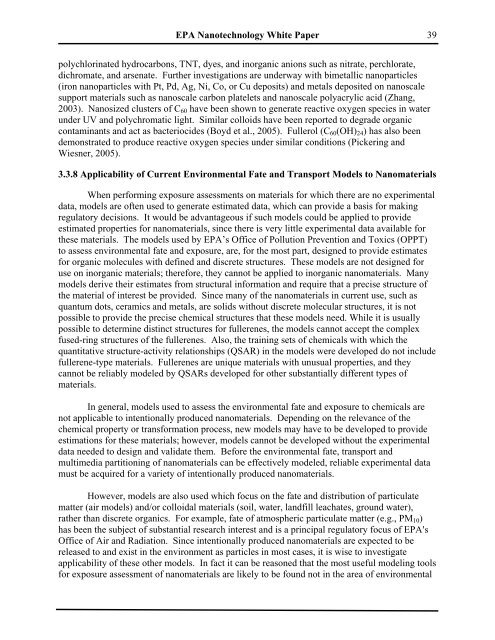Nanotechnology White Paper - US Environmental Protection Agency
Nanotechnology White Paper - US Environmental Protection Agency
Nanotechnology White Paper - US Environmental Protection Agency
You also want an ePaper? Increase the reach of your titles
YUMPU automatically turns print PDFs into web optimized ePapers that Google loves.
EPA <strong>Nanotechnology</strong> <strong>White</strong> <strong>Paper</strong><br />
polychlorinated hydrocarbons, TNT, dyes, and inorganic anions such as nitrate, perchlorate,<br />
dichromate, and arsenate. Further investigations are underway with bimetallic nanoparticles<br />
(iron nanoparticles with Pt, Pd, Ag, Ni, Co, or Cu deposits) and metals deposited on nanoscale<br />
support materials such as nanoscale carbon platelets and nanoscale polyacrylic acid (Zhang,<br />
2003). Nanosized clusters of C60 have been shown to generate reactive oxygen species in water<br />
under UV and polychromatic light. Similar colloids have been reported to degrade organic<br />
contaminants and act as bacteriocides (Boyd et al., 2005). Fullerol (C60(OH)24) has also been<br />
demonstrated to produce reactive oxygen species under similar conditions (Pickering and<br />
Wiesner, 2005).<br />
3.3.8 Applicability of Current <strong>Environmental</strong> Fate and Transport Models to Nanomaterials<br />
When performing exposure assessments on materials for which there are no experimental<br />
data, models are often used to generate estimated data, which can provide a basis for making<br />
regulatory decisions. It would be advantageous if such models could be applied to provide<br />
estimated properties for nanomaterials, since there is very little experimental data available for<br />
these materials. The models used by EPA’s Office of Pollution Prevention and Toxics (OPPT)<br />
to assess environmental fate and exposure, are, for the most part, designed to provide estimates<br />
for organic molecules with defined and discrete structures. These models are not designed for<br />
use on inorganic materials; therefore, they cannot be applied to inorganic nanomaterials. Many<br />
models derive their estimates from structural information and require that a precise structure of<br />
the material of interest be provided. Since many of the nanomaterials in current use, such as<br />
quantum dots, ceramics and metals, are solids without discrete molecular structures, it is not<br />
possible to provide the precise chemical structures that these models need. While it is usually<br />
possible to determine distinct structures for fullerenes, the models cannot accept the complex<br />
fused-ring structures of the fullerenes. Also, the training sets of chemicals with which the<br />
quantitative structure-activity relationships (QSAR) in the models were developed do not include<br />
fullerene-type materials. Fullerenes are unique materials with unusual properties, and they<br />
cannot be reliably modeled by QSARs developed for other substantially different types of<br />
materials.<br />
In general, models used to assess the environmental fate and exposure to chemicals are<br />
not applicable to intentionally produced nanomaterials. Depending on the relevance of the<br />
chemical property or transformation process, new models may have to be developed to provide<br />
estimations for these materials; however, models cannot be developed without the experimental<br />
data needed to design and validate them. Before the environmental fate, transport and<br />
multimedia partitioning of nanomaterials can be effectively modeled, reliable experimental data<br />
must be acquired for a variety of intentionally produced nanomaterials.<br />
However, models are also used which focus on the fate and distribution of particulate<br />
matter (air models) and/or colloidal materials (soil, water, landfill leachates, ground water),<br />
rather than discrete organics. For example, fate of atmospheric particulate matter (e.g., PM10)<br />
has been the subject of substantial research interest and is a principal regulatory focus of EPA=s<br />
Office of Air and Radiation. Since intentionally produced nanomaterials are expected to be<br />
released to and exist in the environment as particles in most cases, it is wise to investigate<br />
applicability of these other models. In fact it can be reasoned that the most useful modeling tools<br />
for exposure assessment of nanomaterials are likely to be found not in the area of environmental<br />
39

















